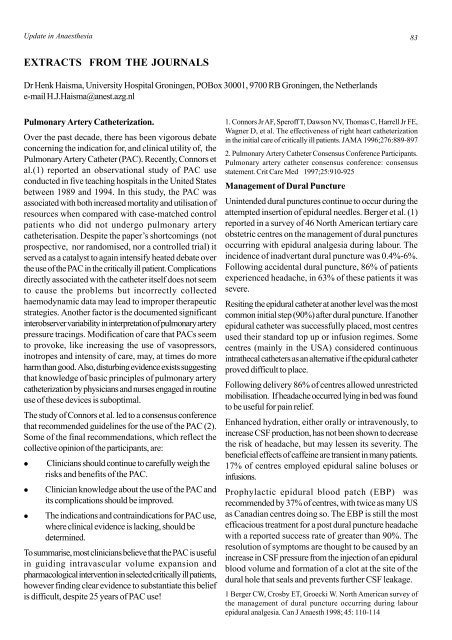Download Update 11 - Update in Anaesthesia - WFSA
Download Update 11 - Update in Anaesthesia - WFSA
Download Update 11 - Update in Anaesthesia - WFSA
You also want an ePaper? Increase the reach of your titles
YUMPU automatically turns print PDFs into web optimized ePapers that Google loves.
<strong>Update</strong> <strong>in</strong> <strong>Anaesthesia</strong> 83EXTRACTS FROM THE JOURNALSDr Henk Haisma, University Hospital Gron<strong>in</strong>gen, POBox 30001, 9700 RB Gron<strong>in</strong>gen, the Netherlandse-mail H.J.Haisma@anest.azg.nlPulmonary Artery Catheterization.Over the past decade, there has been vigorous debateconcern<strong>in</strong>g the <strong>in</strong>dication for, and cl<strong>in</strong>ical utility of, thePulmonary Artery Catheter (PAC). Recently, Connors etal.(1) reported an observational study of PAC useconducted <strong>in</strong> five teach<strong>in</strong>g hospitals <strong>in</strong> the United Statesbetween 1989 and 1994. In this study, the PAC wasassociated with both <strong>in</strong>creased mortality and utilisation ofresources when compared with case-matched controlpatients who did not undergo pulmonary arterycatheterisation. Despite the paper’s shortcom<strong>in</strong>gs (notprospective, nor randomised, nor a controlled trial) itserved as a catalyst to aga<strong>in</strong> <strong>in</strong>tensify heated debate overthe use of the PAC <strong>in</strong> the critically ill patient. Complicationsdirectly associated with the catheter itself does not seemto cause the problems but <strong>in</strong>correctly collectedhaemodynamic data may lead to improper therapeuticstrategies. Another factor is the documented significant<strong>in</strong>terobserver variability <strong>in</strong> <strong>in</strong>terpretation of pulmonary arterypressure trac<strong>in</strong>gs. Modification of care that PACs seemto provoke, like <strong>in</strong>creas<strong>in</strong>g the use of vasopressors,<strong>in</strong>otropes and <strong>in</strong>tensity of care, may, at times do moreharm than good. Also, disturb<strong>in</strong>g evidence exists suggest<strong>in</strong>gthat knowledge of basic pr<strong>in</strong>ciples of pulmonary arterycatheterization by physicians and nurses engaged <strong>in</strong> rout<strong>in</strong>euse of these devices is suboptimal.The study of Connors et al. led to a consensus conferencethat recommended guidel<strong>in</strong>es for the use of the PAC (2).Some of the f<strong>in</strong>al recommendations, which reflect thecollective op<strong>in</strong>ion of the participants, are: Cl<strong>in</strong>icians should cont<strong>in</strong>ue to carefully weigh therisks and benefits of the PAC.Cl<strong>in</strong>ician knowledge about the use of the PAC andits complications should be improved. The <strong>in</strong>dications and contra<strong>in</strong>dications for PAC use,where cl<strong>in</strong>ical evidence is lack<strong>in</strong>g, should bedeterm<strong>in</strong>ed.To summarise, most cl<strong>in</strong>icians believe that the PAC is useful<strong>in</strong> guid<strong>in</strong>g <strong>in</strong>travascular volume expansion andpharmacological <strong>in</strong>tervention <strong>in</strong> selected critically ill patients,however f<strong>in</strong>d<strong>in</strong>g clear evidence to substantiate this beliefis difficult, despite 25 years of PAC use!1. Connors Jr AF, Speroff T, Dawson NV, Thomas C, Harrell Jr FE,Wagner D, et al. The effectiveness of right heart catheterization<strong>in</strong> the <strong>in</strong>itial care of critically ill patients. JAMA 1996;276:889-8972. Pulmonary Artery Catheter Consensus Conference Participants.Pulmonary artery catheter consensus conference: consensusstatement. Crit Care Med 1997;25:910-925Management of Dural PunctureUn<strong>in</strong>tended dural punctures cont<strong>in</strong>ue to occur dur<strong>in</strong>g theattempted <strong>in</strong>sertion of epidural needles. Berger et al. (1)reported <strong>in</strong> a survey of 46 North American tertiary careobstetric centres on the management of dural puncturesoccurr<strong>in</strong>g with epidural analgesia dur<strong>in</strong>g labour. The<strong>in</strong>cidence of <strong>in</strong>advertant dural puncture was 0.4%-6%.Follow<strong>in</strong>g accidental dural puncture, 86% of patientsexperienced headache, <strong>in</strong> 63% of these patients it wassevere.Resit<strong>in</strong>g the epidural catheter at another level was the mostcommon <strong>in</strong>itial step (90%) after dural puncture. If anotherepidural catheter was successfully placed, most centresused their standard top up or <strong>in</strong>fusion regimes. Somecentres (ma<strong>in</strong>ly <strong>in</strong> the USA) considered cont<strong>in</strong>uous<strong>in</strong>trathecal catheters as an alternative if the epidural catheterproved difficult to place.Follow<strong>in</strong>g delivery 86% of centres allowed unrestrictedmobilisation. If headache occurred ly<strong>in</strong>g <strong>in</strong> bed was foundto be useful for pa<strong>in</strong> relief.Enhanced hydration, either orally or <strong>in</strong>travenously, to<strong>in</strong>crease CSF production, has not been shown to decreasethe risk of headache, but may lessen its severity. Thebeneficial effects of caffe<strong>in</strong>e are transient <strong>in</strong> many patients.17% of centres employed epidural sal<strong>in</strong>e boluses or<strong>in</strong>fusions.Prophylactic epidural blood patch (EBP) wasrecommended by 37% of centres, with twice as many USas Canadian centres do<strong>in</strong>g so. The EBP is still the mostefficacious treatment for a post dural puncture headachewith a reported success rate of greater than 90%. Theresolution of symptoms are thought to be caused by an<strong>in</strong>crease <strong>in</strong> CSF pressure from the <strong>in</strong>jection of an epiduralblood volume and formation of a clot at the site of thedural hole that seals and prevents further CSF leakage.1 Berger CW, Crosby ET, Groecki W. North American survey ofthe management of dural puncture occurr<strong>in</strong>g dur<strong>in</strong>g labourepidural analgesia. Can J Anaesth 1998; 45: <strong>11</strong>0-<strong>11</strong>4
















